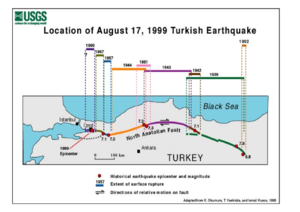
Earthquake storm
Encyclopedia

Earthquake
An earthquake is the result of a sudden release of energy in the Earth's crust that creates seismic waves. The seismicity, seismism or seismic activity of an area refers to the frequency, type and size of earthquakes experienced over a period of time...
s, where one triggers a series of other large earthquakes—along the same plate
Plate tectonics
Plate tectonics is a scientific theory that describes the large scale motions of Earth's lithosphere...
boundary—as the stress transfers along the fault system. This is similar to the idea of aftershock
Aftershock
An aftershock is a smaller earthquake that occurs after a previous large earthquake, in the same area of the main shock. If an aftershock is larger than the main shock, the aftershock is redesignated as the main shock and the original main shock is redesignated as a foreshock...
s, with the exception that they take place years apart. These series of earthquakes can devastate entire countries or geographical regions. Possible events may have occurred during the end of the Bronze Age
Bronze Age
The Bronze Age is a period characterized by the use of copper and its alloy bronze as the chief hard materials in the manufacture of some implements and weapons. Chronologically, it stands between the Stone Age and Iron Age...
, and the latter part of the Roman Empire
Roman Empire
The Roman Empire was the post-Republican period of the ancient Roman civilization, characterised by an autocratic form of government and large territorial holdings in Europe and around the Mediterranean....
. It has been suggested that this is what may be occurring in modern day Turkey
North Anatolian Fault
The North Anatolian Fault is a major active right lateral-moving strike-slip fault in northern Anatolia which runs along the transform boundary between the Eurasian Plate and the Anatolian Plate. The fault extends westward from a junction with the East Anatolian Fault at the Karliova Triple...
.
The term was coined by Stanford Professor of Geophysics Amos Nur in 2000.
See also
- Earthquake swarmEarthquake swarmEarthquake swarms are events where a local area experiences sequences of many earthquakes striking in a relatively short period of time. The length of time used to define the swarm itself varies, but the United States Geological Survey points out that an event may be on the order of days, weeks, or...
- Remotely triggered earthquakesRemotely triggered earthquakesRemotely triggered earthquakes have also been characterized as "the very long reach of very large earthquakes." Fundamentally, it is postulated that large earthquakes can have an influence outside of the immediate aftershock zone, and actually activate other earthquakes at considerable distance...
- Coulomb stress transfer

